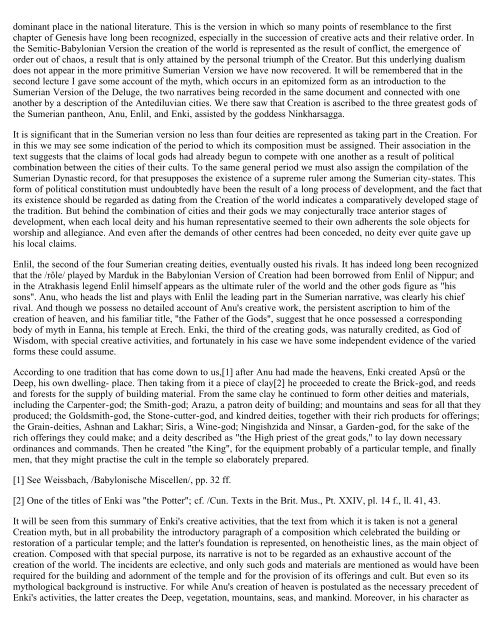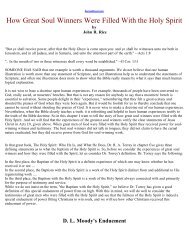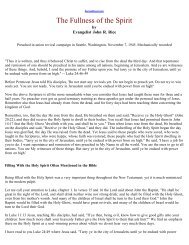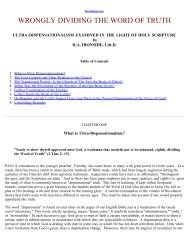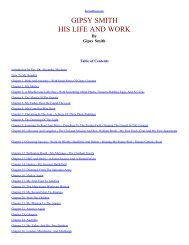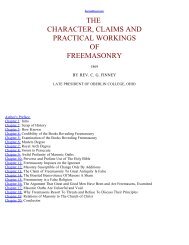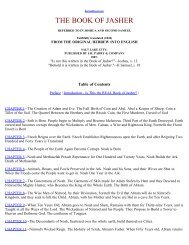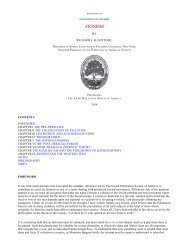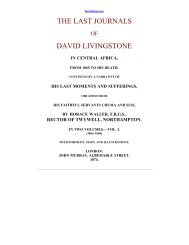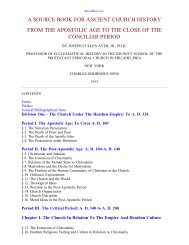Legends of Babylon and Egypt in Relation to Hebrew Tradition.pdf
Legends of Babylon and Egypt in Relation to Hebrew Tradition.pdf
Legends of Babylon and Egypt in Relation to Hebrew Tradition.pdf
Create successful ePaper yourself
Turn your PDF publications into a flip-book with our unique Google optimized e-Paper software.
dom<strong>in</strong>ant place <strong>in</strong> the national literature. This is the version <strong>in</strong> which so many po<strong>in</strong>ts <strong>of</strong> resemblance <strong>to</strong> the first<br />
chapter <strong>of</strong> Genesis have long been recognized, especially <strong>in</strong> the succession <strong>of</strong> creative acts <strong>and</strong> their relative order. In<br />
the Semitic-<strong>Babylon</strong>ian Version the creation <strong>of</strong> the world is represented as the result <strong>of</strong> conflict, the emergence <strong>of</strong><br />
order out <strong>of</strong> chaos, a result that is only atta<strong>in</strong>ed by the personal triumph <strong>of</strong> the Crea<strong>to</strong>r. But this underly<strong>in</strong>g dualism<br />
does not appear <strong>in</strong> the more primitive Sumerian Version we have now recovered. It will be remembered that <strong>in</strong> the<br />
second lecture I gave some account <strong>of</strong> the myth, which occurs <strong>in</strong> an epi<strong>to</strong>mized form as an <strong>in</strong>troduction <strong>to</strong> the<br />
Sumerian Version <strong>of</strong> the Deluge, the two narratives be<strong>in</strong>g recorded <strong>in</strong> the same document <strong>and</strong> connected with one<br />
another by a description <strong>of</strong> the Antediluvian cities. We there saw that Creation is ascribed <strong>to</strong> the three greatest gods <strong>of</strong><br />
the Sumerian pantheon, Anu, Enlil, <strong>and</strong> Enki, assisted by the goddess N<strong>in</strong>kharsagga.<br />
It is significant that <strong>in</strong> the Sumerian version no less than four deities are represented as tak<strong>in</strong>g part <strong>in</strong> the Creation. For<br />
<strong>in</strong> this we may see some <strong>in</strong>dication <strong>of</strong> the period <strong>to</strong> which its composition must be assigned. Their association <strong>in</strong> the<br />
text suggests that the claims <strong>of</strong> local gods had already begun <strong>to</strong> compete with one another as a result <strong>of</strong> political<br />
comb<strong>in</strong>ation between the cities <strong>of</strong> their cults. To the same general period we must also assign the compilation <strong>of</strong> the<br />
Sumerian Dynastic record, for that presupposes the existence <strong>of</strong> a supreme ruler among the Sumerian city-states. This<br />
form <strong>of</strong> political constitution must undoubtedly have been the result <strong>of</strong> a long process <strong>of</strong> development, <strong>and</strong> the fact that<br />
its existence should be regarded as dat<strong>in</strong>g from the Creation <strong>of</strong> the world <strong>in</strong>dicates a comparatively developed stage <strong>of</strong><br />
the tradition. But beh<strong>in</strong>d the comb<strong>in</strong>ation <strong>of</strong> cities <strong>and</strong> their gods we may conjecturally trace anterior stages <strong>of</strong><br />
development, when each local deity <strong>and</strong> his human representative seemed <strong>to</strong> their own adherents the sole objects for<br />
worship <strong>and</strong> allegiance. And even after the dem<strong>and</strong>s <strong>of</strong> other centres had been conceded, no deity ever quite gave up<br />
his local claims.<br />
Enlil, the second <strong>of</strong> the four Sumerian creat<strong>in</strong>g deities, eventually ousted his rivals. It has <strong>in</strong>deed long been recognized<br />
that the /rôle/ played by Marduk <strong>in</strong> the <strong>Babylon</strong>ian Version <strong>of</strong> Creation had been borrowed from Enlil <strong>of</strong> Nippur; <strong>and</strong><br />
<strong>in</strong> the Atrakhasis legend Enlil himself appears as the ultimate ruler <strong>of</strong> the world <strong>and</strong> the other gods figure as "his<br />
sons". Anu, who heads the list <strong>and</strong> plays with Enlil the lead<strong>in</strong>g part <strong>in</strong> the Sumerian narrative, was clearly his chief<br />
rival. And though we possess no detailed account <strong>of</strong> Anu's creative work, the persistent ascription <strong>to</strong> him <strong>of</strong> the<br />
creation <strong>of</strong> heaven, <strong>and</strong> his familiar title, "the Father <strong>of</strong> the Gods", suggest that he once possessed a correspond<strong>in</strong>g<br />
body <strong>of</strong> myth <strong>in</strong> Eanna, his temple at Erech. Enki, the third <strong>of</strong> the creat<strong>in</strong>g gods, was naturally credited, as God <strong>of</strong><br />
Wisdom, with special creative activities, <strong>and</strong> fortunately <strong>in</strong> his case we have some <strong>in</strong>dependent evidence <strong>of</strong> the varied<br />
forms these could assume.<br />
Accord<strong>in</strong>g <strong>to</strong> one tradition that has come down <strong>to</strong> us,[1] after Anu had made the heavens, Enki created Apsû or the<br />
Deep, his own dwell<strong>in</strong>g- place. Then tak<strong>in</strong>g from it a piece <strong>of</strong> clay[2] he proceeded <strong>to</strong> create the Brick-god, <strong>and</strong> reeds<br />
<strong>and</strong> forests for the supply <strong>of</strong> build<strong>in</strong>g material. From the same clay he cont<strong>in</strong>ued <strong>to</strong> form other deities <strong>and</strong> materials,<br />
<strong>in</strong>clud<strong>in</strong>g the Carpenter-god; the Smith-god; Arazu, a patron deity <strong>of</strong> build<strong>in</strong>g; <strong>and</strong> mounta<strong>in</strong>s <strong>and</strong> seas for all that they<br />
produced; the Goldsmith-god, the S<strong>to</strong>ne-cutter-god, <strong>and</strong> k<strong>in</strong>dred deities, <strong>to</strong>gether with their rich products for <strong>of</strong>fer<strong>in</strong>gs;<br />
the Gra<strong>in</strong>-deities, Ashnan <strong>and</strong> Lakhar; Siris, a W<strong>in</strong>e-god; N<strong>in</strong>gishzida <strong>and</strong> N<strong>in</strong>sar, a Garden-god, for the sake <strong>of</strong> the<br />
rich <strong>of</strong>fer<strong>in</strong>gs they could make; <strong>and</strong> a deity described as "the High priest <strong>of</strong> the great gods," <strong>to</strong> lay down necessary<br />
ord<strong>in</strong>ances <strong>and</strong> comm<strong>and</strong>s. Then he created "the K<strong>in</strong>g", for the equipment probably <strong>of</strong> a particular temple, <strong>and</strong> f<strong>in</strong>ally<br />
men, that they might practise the cult <strong>in</strong> the temple so elaborately prepared.<br />
[1] See Weissbach, /<strong>Babylon</strong>ische Miscellen/, pp. 32 ff.<br />
[2] One <strong>of</strong> the titles <strong>of</strong> Enki was "the Potter"; cf. /Cun. Texts <strong>in</strong> the Brit. Mus., Pt. XXIV, pl. 14 f., ll. 41, 43.<br />
It will be seen from this summary <strong>of</strong> Enki's creative activities, that the text from which it is taken is not a general<br />
Creation myth, but <strong>in</strong> all probability the <strong>in</strong>troduc<strong>to</strong>ry paragraph <strong>of</strong> a composition which celebrated the build<strong>in</strong>g or<br />
res<strong>to</strong>ration <strong>of</strong> a particular temple; <strong>and</strong> the latter's foundation is represented, on henotheistic l<strong>in</strong>es, as the ma<strong>in</strong> object <strong>of</strong><br />
creation. Composed with that special purpose, its narrative is not <strong>to</strong> be regarded as an exhaustive account <strong>of</strong> the<br />
creation <strong>of</strong> the world. The <strong>in</strong>cidents are eclective, <strong>and</strong> only such gods <strong>and</strong> materials are mentioned as would have been<br />
required for the build<strong>in</strong>g <strong>and</strong> adornment <strong>of</strong> the temple <strong>and</strong> for the provision <strong>of</strong> its <strong>of</strong>fer<strong>in</strong>gs <strong>and</strong> cult. But even so its<br />
mythological background is <strong>in</strong>structive. For while Anu's creation <strong>of</strong> heaven is postulated as the necessary precedent <strong>of</strong><br />
Enki's activities, the latter creates the Deep, vegetation, mounta<strong>in</strong>s, seas, <strong>and</strong> mank<strong>in</strong>d. Moreover, <strong>in</strong> his character as


